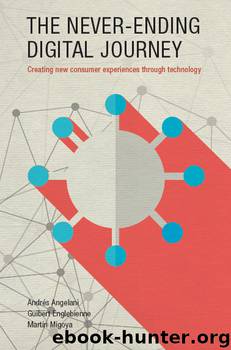The Never-Ending Digital Journey: Creating new consumer experiences through technology by Andrés Angelani Guibert Englebienne Martín Migoya

Author:Andrés Angelani, Guibert Englebienne, Martín Migoya
Language: eng
Format: epub
Publisher: Roundtree Press
Published: 2015-04-14T16:00:00+00:00
Pods are motivated to improve continuously by raising their maturity level, directly benefiting the business by incentivizing partners and motivating employees.
* * *
MATURITY CRITERIA MATURITY CRITERIA SAMPLE REWARDS
The maturity level is a function of a pod meeting its metrics goals. The “grading” process (data is aggregated and compared with the goals) is performed either monthly or quarterly and assigns a maturity level to the pod, which often varies from zero to three.
The weight assigned to one metric versus others in the maturity criteria depends on the order of priorities for each business, such as experience, time to market, cost efficiency, etc. The maturity level will be awarded to pods as a function of the maturity criteria, which derives from this specific order of priorities. To illustrate, we describe below some hypothetical scenarios of weighing metrics priorities to determine the pod’s maturity level in relation to its stage in the Digital Evolution Life Cycle (see Chapter 4).
A pod ecosystem in the ideation-prove loop (see “The Never-Ending Digital Journey” diagram in Chapter 4) may define a maturity criteria giving 40 percent weight to production metrics and 60 percent on business metrics, because prototypes at this stage are proven before they are scaled to become production-ready digital journeys. So, there’s great emphasis on design and meeting the product quality goals, providing a better experience.
A pod ecosystem in the “scale” stage (see Chapter 4) may adopt a maturity criteria defined by a 60 percent weight on production metrics and a 40 percent weight on business metrics. At scale, time to market is critical to get to production quickly and at quality, in order to enable a phase of evolution that starts when users’ insights are incorporated. A typical example is getting to a minimum viable product (MVP) successfully and iterating based on feedback, enhancing the product iteratively. In addition, production metrics may be more important at scale because there’s likely a higher budget burn at this stage.
A pod ecosystem in the evolve stage, i.e., with a good number of journeys running in production, may have a maturity criteria giving 50 percent weight to business metrics and 50 percent to production metrics. In the “evolve” stage, it’s critical for the digital journey to meet the business goals that will enable returns and activate another wave of invention. It’s also important that pods perform and are cost efficient in order to fund the next wave of invention.
TRACKING POD STAGES
The pods management tool, or GoPods (see Afterword), integrates with several other development tools and pulls specific standard metrics to help it track and monitor these various metrics, such as productivity, quality, and velocity. By pulling in these metrics from development tools such as JIRA, Jenka, Sonar, Bamboo, and others, GoPods is able to automatically merge all this data around product quality and velocity and place the pod within a maturity path. In doing so, GoPods aggregate data to help update, track, and monitor the progress of the software development by pod, product, project, or the entire ecosystem.
Download
This site does not store any files on its server. We only index and link to content provided by other sites. Please contact the content providers to delete copyright contents if any and email us, we'll remove relevant links or contents immediately.
Bad Blood by John Carreyrou(5763)
Principles: Life and Work by Ray Dalio(5315)
Rich Dad Poor Dad by Robert T. Kiyosaki(5140)
Management Strategies for the Cloud Revolution: How Cloud Computing Is Transforming Business and Why You Can't Afford to Be Left Behind by Charles Babcock(4127)
The Confidence Code by Katty Kay(3562)
Thinking in Bets by Annie Duke(3528)
American Kingpin by Nick Bilton(2966)
Playing to Win_ How Strategy Really Works by A.G. Lafley & Roger L. Martin(2922)
Delivering Happiness by Tony Hsieh(2919)
Project Animal Farm: An Accidental Journey into the Secret World of Farming and the Truth About Our Food by Sonia Faruqi(2656)
Brotopia by Emily Chang(2589)
I Live in the Future & Here's How It Works by Nick Bilton(2521)
Mastering Bitcoin: Programming the Open Blockchain by Andreas M. Antonopoulos(2507)
The Content Trap by Bharat Anand(2490)
The Power of Habit by Charles Duhigg(2484)
The Marketing Plan Handbook: Develop Big-Picture Marketing Plans for Pennies on the Dollar by Robert W. Bly(2409)
The Tyranny of Metrics by Jerry Z. Muller(2399)
Building a StoryBrand by Donald Miller(2358)
Applied Empathy by Michael Ventura(2325)
